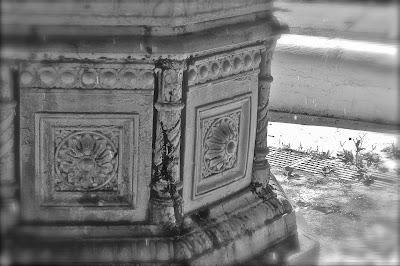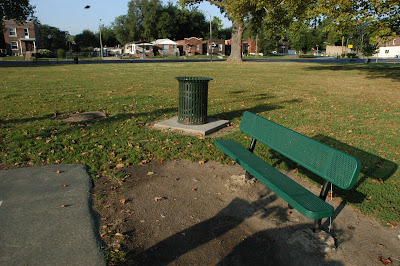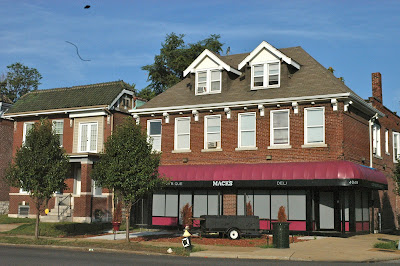The park is surrounded by Fountain Avenue:
The park has been in existence since 1889 and still looks pretty good. The homes and buildings that immediately surround the park range from well maintained to trashed and vacant.
When the Aubert Place subdivision was laid out by John Lay in 1857, a central oval shaped area was reserved for a Park space. In 1889, it was donated by Lay to the City and was named Fountain Park, because of the fountain which was placed there was as a gift from the Merchants Exchange. (source)The fountain for which the park takes its name is still operational and majestic.
The areas further out are not nice, welcoming places, per my personal experience, I would claim them amongst the worst in St. Louis. Abandonment, mixed with blind eyes turned on the negative behavior that exists here today.
Think I'm being dramatic? Statistically, this is the 12th most violent neighborhood in America. KSDK was one of many local media sources to run this story back in April, 2013:
The area bordered by N. Kingshighway Boulevard on the west, Page Boulevard on the north, N. Taylor Avenue on the east, and Delmar Boulevard on the south tied an area of Chicago for 12th place. This area is comprised of parts of the Fountain Park and Lewis Place neighborhoods.But, the park itself is still beautiful. It recently got some new park benches and trash cans, 1 burnt, the others still okay.
Other than that, it is a simple park with a fountain at its center, a Dr. Martin Luther King Jr. statue on one end and a tiered planter on the other.
There are some old growth oaks that are stunning.
Why is the MLK statue surrounded by a damaged fence? Is this to keep out vandals? This neighborhood is 99% black per the 2010 Census data, who would destroy/deface this?
It's just weird to see a monument to one of the greatest figures in American history with a plaque that reads: "His Dream - Our Dream". And then surrounded by a beat up fence.
As I mentioned before the oval Fountain Avenue surrounds the park. There is a bike lane around the park and the homes range from well maintained to decent to trashed and abandoned.
The crumbling former business nearest the northeast corner of the park is awesome but quickly deteriorating worse and worse every time I make it up here.
On today's visit, the sidewalk manholes had been stolen/scrapped and the sidewalks are nearly impassible.
It's a shame this neighborhood has gotten to this point.











































































































